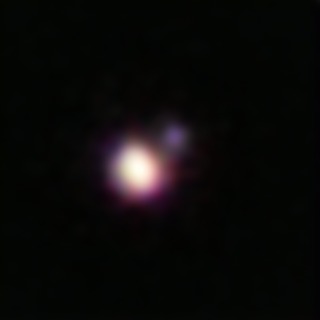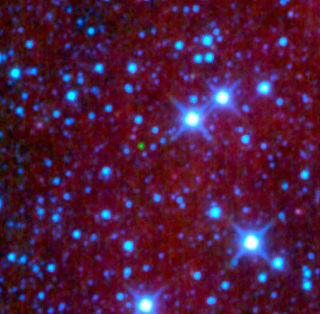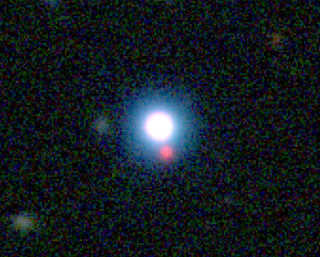Related Research Articles
DENIS-P J020529.0−115925 is a brown dwarf system in the constellation of Cetus. It is located 64 light-years away, based on the system's parallax. It was first found in the Deep Near Infrared Survey of the Southern Sky.
ULAS J003402.77-005206.7 is a Y-type brown dwarf in the constellation of Cetus.

CFBDSIR J145829+101343 is a binary system of two brown dwarfs of spectral classes T9 + Y0 orbiting each other, located in constellation Boötes about 104 light-years away from Earth.

WISEPC J045853.90+643451.9 is a binary system of two ultracool brown dwarfs of spectral classes T8.5 and T9.5, respectively, located in constellation Camelopardalis at approximately 47 ly from Earth.

WISE 1541−2250 is a sub-brown or brown dwarf of spectral class Y0.5, located in the constellation Libra at approximately 18.6 light-years from Earth. This object received popular attention when its discovery was announced in 2011 at a distance estimated to be only about 9 light-years, which would have made it the closest brown dwarf known.. It is not the farthest known Y-type brown dwarf to Earth.

WISE 1828+2650 is a possibly binary brown dwarf or rogue planet of spectral class >Y2, located in constellation Lyra at approximately 32.5 light-years from Earth. It is the "archetypal member" of the Y spectral class.
WISE 2056+1459 is a brown dwarf of spectral class Y0, located in constellation Delphinus at approximately 23.2 light-years from Earth.
WISEPA J173835.53+273258.9 is a brown dwarf of spectral class Y0, located in constellation Hercules at 25.5 light-years from Earth.
WISEPC J140518.40+553421.4 is a brown dwarf of spectral class Y0 (pec?), located in constellation Ursa Major at approximately 25.3 light-years from Earth. It is one of the Sun's nearest neighbors.
WISEPA J174124.26+255319.5 is a brown dwarf of spectral class T9, located in constellation Hercules at approximately 15.2 light-years from Earth.
WISEPA J025409.45+022359.1 is a brown dwarf of spectral class T8, located in constellation Cetus at approximately 22.3 light-years from Earth.
WISEPC J150649.97+702736.0 is a brown dwarf star of spectral class T6, located in constellation Ursa Minor. It is one of the Sun's nearest neighbors, at a distance of 16.85 light-years. Brown dwarfs closer to the Sun include Luhman 16 and WISE 0855−0714. Other brown dwarfs that may be closer to the Sun include ε Indi Ba and ε Indi Bb at 11.8 light-years and WISE 0350-5658 at 12.1+5.2
−1.3 light-years.

J. Davy Kirkpatrick is an American astronomer at the Infrared Processing and Analysis Center at the California Institute of Technology in Pasadena, California. Kirkpatrick's research was named one of the top ten science accomplishments of the first ten years (1992–2002) of the W. M. Keck Observatory and one of the Top 100 Stories of 2011 by Discover Magazine.
WISE J035934.06−540154.6 is a brown dwarf of spectral class Y0, located in constellation Reticulum. Estimated to be approximately 22.5 light-years from Earth, it is one of the Sun's nearest neighbors.
2MASS J11145133−2618235, or 2M1114−26, or 2M1114−2618, or 2MASS 1114−26, or 2MASS J1114−2618) is a nearby brown dwarf of spectral class T7.5, located in constellation Hydra at approximately 18 light-years from Earth.
Kelu-1 is a system of two brown dwarfs of spectral types L2 and L4 located in constellation Hydra at approximately 60.6 light-years from Earth. It is among the first free-floating later-than-M-type brown dwarfs discovered, and sometimes considered as prototype of L-type brown dwarfs.
DENIS-P J1058.7-1548 is a brown dwarf of spectral type L3, located in constellation Crater at approximately 17.3 parsecs or 56.5 light-years from Earth. Its spectrum was used as a standard to define the spectral class L3 back in 1997. With a surface temperature of between 1700 and 2000 K, it is cool enough for clouds to form. Variations in its brightness in visible and infrared spectra suggest it has some form of atmospheric cloud cover.

GD 165 is a system of a white dwarf and a brown dwarf of spectral types DA4 + L4, located in constellation Boötes at approximately 103 light-years from Earth. GD 165 B remained the only brown dwarf companion of a white dwarf until the discovery of GD 1400 B, which was discovered 17 years later.

2MASS J22282889–4310262 is a brown dwarf discovered by the Hubble Space Telescope and The Spitzer Space Telescope in 2013. Using Hubble and Spitzer, NASA astronomers were able to develop the most detailed 'weather map' for brown dwarfs, utilizing different wavelengths of infrared light to show changing light patterns and different layers of material in the windstorms. This observation was the first time that researchers were able to probe such variability at different altitudes of a brown dwarf. In the outer layers of its atmosphere, gases condense into raindrop-like particles made up of sand and iron which fall into the interior.
References
- 1 2 Cutri, Roc M.; Skrutskie, Michael F.; Van Dyk, Schuyler D.; Beichman, Charles A.; Carpenter, John M.; Chester, Thomas; Cambresy, Laurent; Evans, Tracey E.; Fowler, John W.; Gizis, John E.; Howard, Elizabeth V.; Huchra, John P.; Jarrett, Thomas H.; Kopan, Eugene L.; Kirkpatrick, J. Davy; Light, Robert M.; Marsh, Kenneth A.; McCallon, Howard L.; Schneider, Stephen E.; Stiening, Rae; Sykes, Matthew J.; Weinberg, Martin D.; Wheaton, William A.; Wheelock, Sherry L.; Zacarias, N. (2003). "VizieR Online Data Catalog: 2MASS All-Sky Catalog of Point Sources (Cutri+ 2003)". CDS/ADC Collection of Electronic Catalogues. 2246: II/246. Bibcode:2003yCat.2246....0C.
- 1 2 3 "DENIS-P J1228.2-1547". SIMBAD . Centre de données astronomiques de Strasbourg . Retrieved 27 December 2016.
- ↑ Faherty, Jacqueline K. (2012). "The Brown Dwarf Kinematics Project (BDKP). III. Parallaxes for 70 Ultracool Dwarfs". The Astrophysical Journal. 752 (1): 56. arXiv: 1203.5543 . Bibcode:2012ApJ...752...56F. doi:10.1088/0004-637X/752/1/56. S2CID 18160586.
- ↑ Dupuy, Trent J.; Liu, Michael C. (2012). "The Hawaii Infrared Parallax Program. I. Ultracool Binaries and the L/T Transition". The Astrophysical Journal Supplement . 201 (2): 19. arXiv: 1201.2465 . Bibcode:2012ApJS..201...19D. doi:10.1088/0067-0049/201/2/19. S2CID 119256363.
- ↑ Dahn, C. C.; Harris, Hugh C.; Vrba, Frederick J.; Guetter, Harry H.; Canzian, Blaise; Henden, Arne A.; Levine, Stephen E.; Luginbuhl, Christian B.; Monet, Alice K. B.; Monet, David G.; Pier, Jeffrey R.; Stone, Ronald C.; Walker, Richard L.; Burgasser, Adam J.; Gizis, John E.; Kirkpatrick, J. Davy; Liebert, James; Reid, I. Neill (2002). "Astrometry and Photometry for Cool Dwarfs and Brown Dwarfs". The Astronomical Journal . 124 (2): 1170–1189. arXiv: astro-ph/0205050 . Bibcode:2002AJ....124.1170D. doi:10.1086/341646. S2CID 119485007.
- 1 2 Delfosse, Xavier; Tinney, Chris G.; Forveille, Thierry; Epchtein, Nicolas; Bertin, Emmanuel; Borsenberger, Jean; Copet, Éric; de Batz, Bertrand; Fouqué, Pascal; Kimeswenger, Stefan; Le Bertre, Thibaut; Lacombe, François; Rouan, Daniel; Tiphène, Didier (1997). "Field brown dwarfs found by DENIS". Astronomy and Astrophysics . 327: L25–L28. Bibcode:1997A&A...327L..25D.
- ↑ Martín, Eduardo L.; Brandner, W.; Basri, Gibor (1999). "A Search for Companions to Nearby Brown Dwarfs: The Binary DENIS-P J1228.2-1547". Science . 283 (5408): 1718–1720. Bibcode:1999Sci...283.1718M. doi:10.1126/science.283.5408.1718. PMID 10073933.
- ↑ Kirkpatrick, J. Davy; Beichman, Charles A.; Skrutskie, Michael F. (1997). "The Coolest Isolated M Dwarf and Other 2MASS Discoveries". The Astrophysical Journal . 476 (1): 311–318. Bibcode:1997ApJ...476..311K. doi: 10.1086/303613 .
- ↑ Ruiz, Maria Teresa; Leggett, S. K.; Allard, France (1997). "Kelu-1: A Free-floating Brown Dwarf in the Solar Neighborhood". The Astrophysical Journal Letters . 491 (2): L107–L110. Bibcode:1997ApJ...491L.107R. doi: 10.1086/311070 .